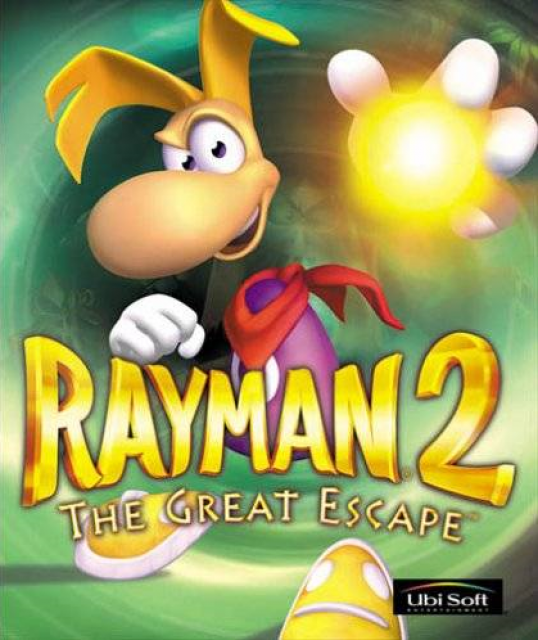Overview
Rayman 2: The Great Escape is a 3D platformer that was developed by Ubisoft and first released in 1999. Players take control of Rayman, a limbless hero whose main attack is shooting his fists and energy balls at his opponents. This is the first Rayman game to be made in 3D. Rayman's powers include shooting his fists (which take the form of energy balls) and his helicopter ears (which allow him to descend slowly, and sometimes fly). He is also able to grab onto ledges and attain new heights via the use of purple lums. Lastly, he is able to innovate, riding a plum down a river of lava, riding on the back of a rocket, flying with a flaming gunpower barrel, and hitching a ride attached to a swamp creature named Ssssam.
Unlike its predecessor, Rayman 2's visual design and score strike a much more dark and dreary tone, while still not taking away the mystifying and vibrant universe that is iconic to the Rayman games. Levels range from marshlands to oceanic bays to crazy dreamworlds to lava temples and robot pirate ship grottoes.
Rayman 2 received positive reviews from critics, who highlighted the fact that the series managed to make the transition from 2D to 3D much more seamlessly than a number of other similar platformers.
Plot
On a dark and stormy night, Ly the Fairy reaches out to Rayman for help. The world is in trouble. Admiral Razorbeard and his pirate army have taken over most of the world and enslaved its inhabitants. Unfortunately, Rayman has been captured and put aboard the pirate ship Buccaneer. His friend Globox is thrown into a room with him shortly after, and Rayman remarks to his old friend that he feels weak, and that this may be the end. Luckily, Globox had been given a silver lum by Ly, which in turn he gives to Rayman. It rejuvenates him, and together they bust out of the ship.
After a long trip down, Rayman lands in the Woods of Light, one of the few places the pirates have not infiltrated. Globox is nowhere to be found, but Rayman does come into contact with Murfy, who provides him with guidance. He also finds the Teensies, who show him the way to the Hall of Doors. Once there, Rayman travels to the Fairy Glade, where he saves a weakened Ly the Fairy from the pirates. He then learns how dire the situation really is. The pirates hold sway in almost all corners of the world. Razorbeard has also split the heart of the world into 1000 lums and scattered them throughout.
To set things right, Rayman needs to find the 4 masks of power. Only by having these 4 masks can he summon Polokus, the creator of the world, who will then be able to destroy the pirates once and for all. As soon as Rayman gets this information, he is off. Along the way, he will encounter much resistance, many challenges, and a pirate captain bent on the destruction of his world. No problem, for a hero without limbs.
Characters
Rayman 2 features an array of imaginative and colorful characters, perfectly complementing the exciting gameplay experience.
RaymanRayman is an unsuspecting hero who is dragged into the fight against the pirates, while also being responsible for repairing the damage that has been done to the world through the collection of items known as lums. Clearly the plight of the world is close to his heart, as he is friends to a number of the creatures of the forest including Globox and Ly.
|
GloboxGlobox is a dear friend of Rayman that you first encounter at the beginning of the game as you help him to escape from his pirate cell. Despite being a huge coward, Globox can often be useful throughout the game with his ability to use magic, an example being his special ‘rain-dance’.
|
MurfyFollowing the tradition of many games in the platforming genre, Rayman 2 also features a tutorial fairy, known as Murfy. Responsible for introducing the player to various game mechanics and items, Murfy clearly is an important ally for those new to the game. Murfy can be summoned by the player standing on his corresponding tile.
|
LyLy the fairy is another friend of Rayman who helps him out in a different way to Murfy. During their first encounter (in which Rayman rescues Ly from being held captive by the pirates), Ly gives Rayman the power to use purple lums. Ly also helps to grant Rayman greater power throughout the progress of the game, through items known as silver lums.
|
RazorbeardRazorbeard is the leader of the evil robot pirates, and forms an inexplicably evil adversary to Rayman. With an army of giant airships and hordes of evil minions he clearly poses a great threat to the sanctity of the world. His evil deeds know no bounds, as we discover that he has imprisoned many of the creatures of the land and has ravaged the world of its magical power (the lums), which Rayman must find scattered throughout the world.
|
PolokusPolokus is an ancient being that sits on a totem in the Spirit World awaiting the four magic masks, which Rayman is required to locate. Only after awakening the spirit of Polokus does Rayman truly stand a chance of defeating the pirates.
|
ClarkThe buff, broad-shouldered, balloon-chinned giant known as Clark is another friend of Rayman. He is first encountered in the Menhir Hills level, where he asks Rayman to bring him medicine from the Cave of Bad Dreams. After he has been cured, he allows Rayman to ride on top of his back as he smashes through walls. He returns later in the game in a mind-controlled state as a mini-boss that Rayman must defeat.
|
CarmenCarmen the whale is another odd friend of Rayman who is also captured by the pirates and must be freed by Rayman. In the PlayStation version Carmen leads Rayman to the Temple of Water and Ice; in all other versions she leads him out of the level.
|
SssssamSssssam the snake acts as the ferryman of the glades. He is trapped in a cage by the evil pirates, but is rescued by Rayman during the game. To show his gratitude, Sssssam then gives Rayman a ride through the Marshes of Awakening along a treacherous water ski-like course, at the end of which he leaves Rayman to continue his adventure alone. |
Releases
PlayStation
The PlayStation version only featured fewer lums to collect as well as truncated level design to compensate for the system hardware. This version also features enemies and boss fights not seen in any other version including an enemy last seen in the original Rayman. Along with the PlayStation 2 version, the game featured complete voice overs for the dialogue.
Nintendo 64
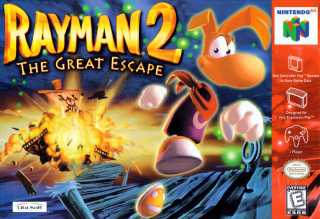
The Nintendo 64 version featured compatibility with the N64 Expansion Pak. It also featured music converted and fitted to work with the hardware as the other versions used CD audio. This was also the base version of Rayman DS and is similar to the PC version.
PC/Windows

The PC version runs similar to the Nintendo 64 version retaining some features from the disc based versions. It can run at high resolutions and features the best quality sound out of all the other versions. The PC version suffers from a few issues such as un-customizable controls for both keyboard and joystick/gamepads and the installer is incompatible with 64-bit processors and cannot be installed on such platforms. This version is currently available for purchase on GOG.com and is able to run on 64-bit systems due to a different installer wrapper. It was also given free to pre-purchase owners of Rayman Origins on Steam.
Sega Dreamcast
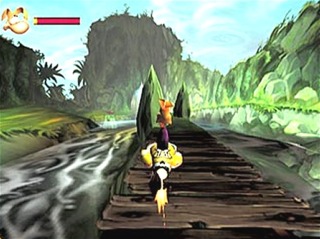
The Dreamcast version is considered the best version of the game with higher resolution graphics, fast framerate, and extra features including online downloadable content such as mini games and a 4 player multiplayer mode. Levels are given additional geometry and effects to take advantage of the hardware compared to the versions released before. This version added 6 Globox Crystals hidden in a few levels that could be taken to the Globox Village to unlock bonuses. This was also the base version of Rayman 3D.
Playstation 2 (Rayman 2 Revolution)
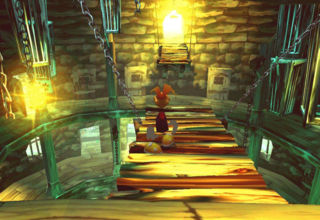
The Playstation 2 version was an even further enhanced version of Rayman 2 running on the Renderware engine. Graphics were given more detail, levels were expanded and the world map was replaced with a hub world that would also feature a more prominent appearance of other characters such as Clark and Carmen. Cutscenes are expanded and is given speech for all supported languages and features more detailed "Raymanian" speech. This version also suffers from some framerate issues and sound glitches. Currently this version of the game is available for download on the Playstation Store for Playstation 3 owners.
Nintendo DS (Rayman DS)
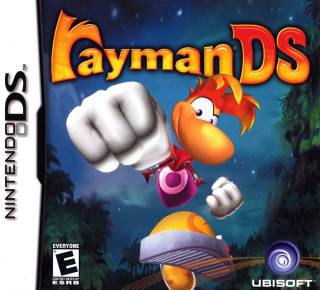
Rayman 2 was ported to the DS soon after it's launch under the name "Rayman DS" to capitalize on the launch window of the Nintendo DS system and intended to take advantage of the success similar to Rayman Advance on Game Boy Advance. Converted from the Nintendo 64 version by DC Studios, it faced several conversion issues. For example due to the smaller cartridge size, certain textures are compressed and certain indicators are unintelligible due to improper scaling. Much like Super Mario 64's DS, players could utilize the touch screen as a replicated analog control stick, but was criticized as being too imprecise.
Nintendo 3DS (Rayman 3D)
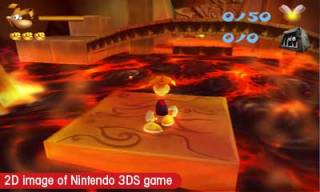
The Nintendo 3DS version was converted from the Sega Dreamcast version and makes use of the analog slide pad for analog control and the system's 3D capabilities.The difficulty has been toned down to better adapt for quick play on the handheld format similar to the DSi port of the original Rayman. The game now saves after each section or cutscene, Rayman rotates with the camera when holding left or right on the D-Pad to turn the camera, health refills after being inflicted with instant death and certain sections have been altered for easier progress. The game was poorly adapted to the hardware to make it in time for system launch and has received numerous faults. The framerate is wildly inconsistent and sluggish at more intense areas, sound effects are missing or cut out during normal gameplay while music sounds overdriven, certain skybox textures alias incorrectly, certain scenery and objects are incorrectly scaled, and texture work sometimes appears stretched or missing. Reports indicated prior to launch that the 4 player mini game would return for local wireless multiplayer, however it does not exist in the final version as the Dreamcast DLC, Globox Village and collectables associated with it have been removed from this version.
iPhone/iPad
Gameloft has converted the game to the iPhone which is also compatible with iTouch, and iPad. Controls are entirely touch based with "Virtual" joysticks and key actions mapped to the screen.
Some boss characters, such as Colossus and Ninjaws do not appear in every version. Interactive cut-scenes are also cut from certain versions.
Game Boy Color Version (Rayman 2 Revolution)
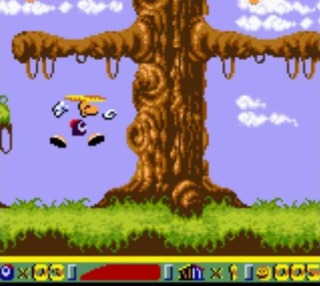
Much like Rayman 1 on Game Boy Color, Rayman 2 saw an 8-bit portable rendition on Nintendo's handheld and features new levels and content. In the US, it shared the same name as the major console version. Whereas in the UK, it was named Rayman 2 Revolution but is not to be confused with the Playstation 2 version. Playing similarly to Rayman on Game Boy Color, creatures are locked away in cages and must be freed by Rayman in order to fight back the pirate army. Unlike the last Game Boy title, the password system was replaced by a battery back-up save system to keep and restore progress and does not contain any Ubi-Key features.
PC Requirements
- Windows 95/98
- Pentium 133 (Min.)
- 4x CD-ROM drive (Min.)
- 32 MB RAM (Min.)
- 4MB D3D compatible graphics card.
- DirectX compatible sound card.
- 300MB free hard drive space.

 PlayStation 2
PlayStation 2 PlayStation
PlayStation Dreamcast
Dreamcast Nintendo DS
Nintendo DS.png) PlayStation Network (PS3)
PlayStation Network (PS3) PC
PC iPhone
iPhone.png) PlayStation Network (PSP)
PlayStation Network (PSP) Nintendo 3DS
Nintendo 3DS.png) PlayStation Network (Vita)
PlayStation Network (Vita)





























